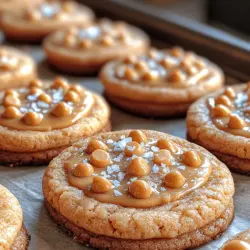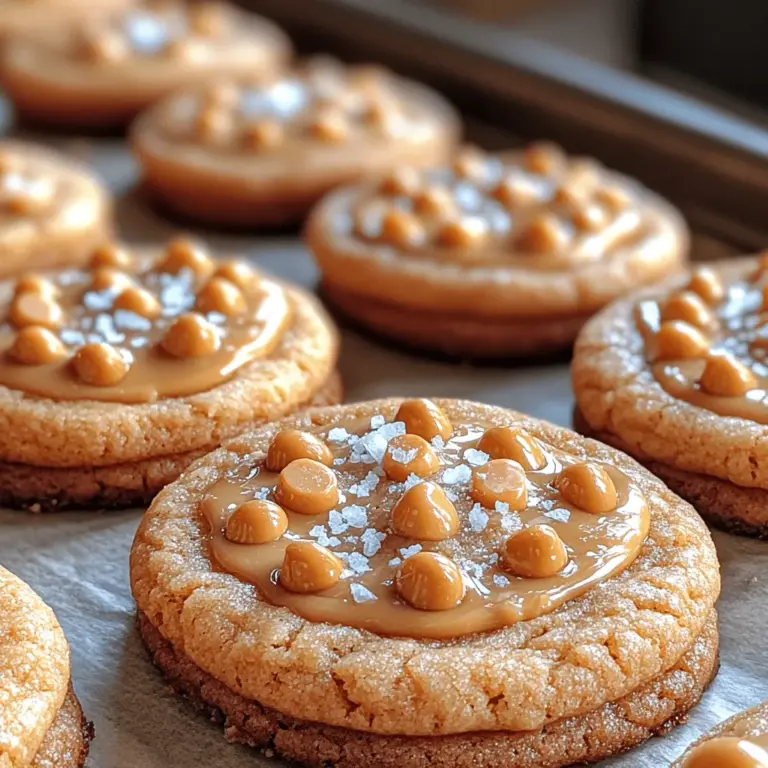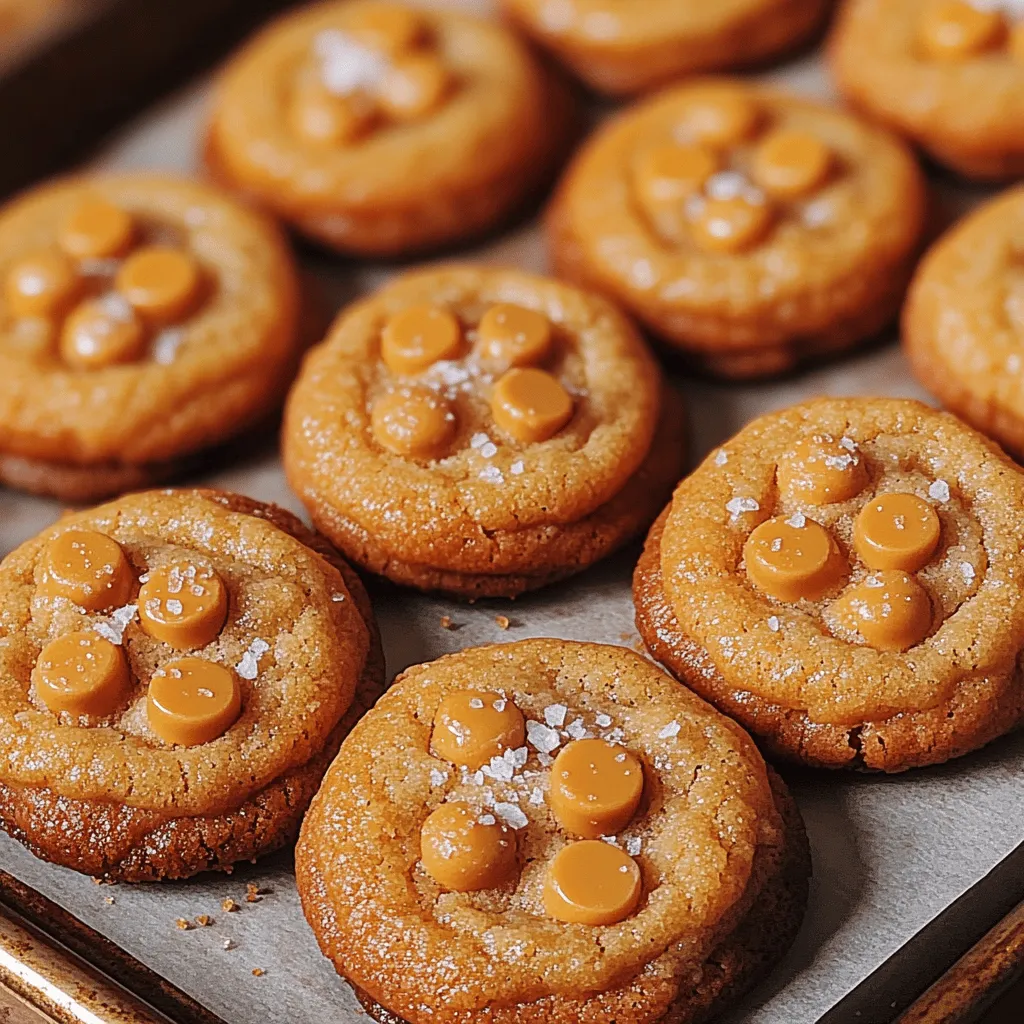Introduction
Few treats capture the heart quite like cookies, and when it comes to flavor combinations, nothing is quite as delightful as the mixture of sweet and salty. Enter the salted butterscotch cookie, a heavenly creation that strikes the perfect balance between rich sweetness and the satisfying crunch of salt. These cookies offer a comforting, indulgent experience that makes them a favorite across all ages.
Butterscotch has long been a beloved ingredient in baking, revered for its sweet, buttery flavor profile that evokes nostalgia. Whether you remember the butterscotch candies of your childhood or have recently discovered the magic of butterscotch in desserts, its popularity in cookie recipes is undeniable. The rich, caramel-like flavor pairs beautifully with the contrasting notes of flaky sea salt, which adds a touch of sophistication while amplifying the sweetness of the butterscotch.
In this guide, we will walk you through the delightful process of baking salted butterscotch cookies, ensuring that you have all the tips and tricks needed for cookie perfection. By the end of this article, you will be equipped with everything necessary to create these mouthwatering cookies, capturing the sweet and salty bliss in every bite.
Understanding the Ingredients
Before we dive into the baking process, it’s essential to understand the role of each ingredient in the recipe. Each component contributes to the overall texture, flavor, and success of the cookies, ensuring that they emerge from the oven as a soft, chewy delight.
Unsalted Butter
The foundation of any great cookie is butter, and unsalted butter is the preferred choice for this recipe. Softened to room temperature, unsalted butter provides the perfect texture, allowing for easy creaming with sugars. The absence of salt in unsalted butter gives you full control over the salt levels in your cookies, allowing the flaky sea salt to shine through as a delightful finishing touch.
Sugars
In this recipe, both brown sugar and granulated sugar are used, each playing a vital role in flavor and moisture. Brown sugar, with its molasses content, lends a rich, caramel flavor and contributes to the cookie’s chewy texture. Granulated sugar, on the other hand, helps achieve a slight crispness on the outer edges, creating a delightful contrast with the soft middle of the cookie.
Eggs
Eggs serve as a binding agent in the cookie dough, providing structure and richness. The inclusion of eggs not only helps hold the ingredients together but also contributes to the overall moisture and tenderness of the cookies. Using large eggs is recommended, as their size ensures the right balance of liquid and fat in the dough.
Vanilla Extract
A splash of pure vanilla extract works wonders in enhancing the flavor profile of these cookies. Vanilla adds depth and warmth, rounding out the sweetness and complementing the butterscotch beautifully. For the best results, consider using high-quality vanilla extract, as it significantly elevates the taste of your baked goods.
All-Purpose Flour
All-purpose flour serves as the backbone of the cookie dough, providing structure and stability. The right amount of flour is crucial; too much can lead to dry cookies, while too little can result in a flat cookie. Be sure to measure your flour accurately, spooning it into your measuring cup and leveling off the top for precision.
Baking Soda
Baking soda is a leavening agent that helps the cookies rise and spread during baking. It reacts with the acidic components in the brown sugar and creates carbon dioxide bubbles, resulting in a lighter and fluffier cookie. It’s important to ensure that your baking soda is fresh for optimal results.
Salt
While salt might seem counterintuitive in a sweet recipe, it plays a crucial role in balancing flavors. A pinch of salt enhances the sweetness of the butterscotch and helps elevate the overall flavor profile of the cookies. It also helps to intensify the taste of the other ingredients, making each bite more satisfying.
Butterscotch Chips
Butterscotch chips are the star of this cookie recipe, bringing their signature sweet and buttery flavor to every morsel. They melt slightly during baking, creating pockets of gooey goodness that contrast beautifully with the chewy texture of the cookie. If you’re a fan of butterscotch, feel free to add extra chips for an even more indulgent experience.
Flaky Sea Salt
The finishing touch on these cookies is the sprinkle of flaky sea salt. This ingredient not only enhances the flavor but also adds a beautiful visual appeal. The salt crystals offer a delightful crunch that complements the soft cookie, creating an irresistible sweet-and-salty experience.
Step-by-Step Instructions to Perfect Salted Butterscotch Cookies
Now that we understand the importance of each ingredient, let’s move on to the exciting part – baking the cookies! Here’s a step-by-step guide to ensure your salted butterscotch cookies turn out perfectly every time.
Prepping the Kitchen: Tools and Equipment Needed
Before you start baking, gather all the necessary tools and equipment to streamline the process. Here’s what you will need:
– Mixing Bowls: Use a large mixing bowl for creaming the butter and sugars, and a smaller bowl for mixing dry ingredients.
– Electric Mixer: A handheld or stand mixer will make the creaming process easier, ensuring a light and fluffy cookie dough.
– Measuring Cups and Spoons: Accurate measurements are key for successful baking.
– Rubber Spatula: For scraping down the sides of the bowl and folding in ingredients.
– Baking Sheet: A sturdy baking sheet lined with parchment paper or a silicone baking mat will ensure even baking and prevent sticking.
– Cooling Rack: Allow your cookies to cool properly after baking for the best texture.
Preheat and Prepare: Setting Up for Success
Before you begin mixing your ingredients, preheat your oven to 350°F (175°C). Preheating is crucial, as it ensures that your cookies bake evenly and achieve the desired texture. While the oven heats up, line your baking sheet with parchment paper or a silicone baking mat to prevent the cookies from sticking and to aid in easy cleanup.
Creaming the Butter and Sugars: The Foundation of Fluffy Cookies
The first step in creating your cookie dough is to cream the softened unsalted butter with both brown sugar and granulated sugar. In your large mixing bowl, combine 1 cup of softened unsalted butter with 3/4 cup of brown sugar and 1/2 cup of granulated sugar. Using your electric mixer, beat the mixture on medium speed until it’s light and fluffy, about 2-3 minutes.
This creaming method is essential for incorporating air into the dough, which contributes to a lighter texture in the finished cookies. The result should be a pale, creamy mixture with a smooth consistency. Don’t rush this step; taking the time to cream properly will pay off in the final product.
Incorporating Eggs and Vanilla: Building Flavor and Texture
Once your butter and sugars are creamed together, it’s time to add the eggs and vanilla extract. Add 2 large eggs, one at a time, mixing well after each addition. This method ensures that the eggs are fully incorporated into the dough, providing the necessary moisture and binding properties.
After adding the eggs, pour in 1 teaspoon of pure vanilla extract. Continue mixing on low speed until everything is well combined. The mixture should be smooth and creamy, with no visible streaks of egg or butter.
With these foundational steps complete, you’re well on your way to creating a batch of delicious salted butterscotch cookies. Stay tuned for the next part of this recipe, where we will explore the remaining steps, including the dry ingredient mix and the baking process that leads to cookie perfection.
Tips for Ensuring a Smooth Mixture and Preventing Curdling
To achieve a perfectly smooth mixture for your salted butterscotch cookies, it’s vital to incorporate your ingredients correctly. Start by allowing your butter and eggs to come to room temperature before mixing. Cold ingredients can cause the butter to harden, leading to an uneven mixture. Beat the butter until it is light and fluffy before gradually adding the sugars. This process incorporates air into the mixture, which helps create a tender cookie texture.
When adding eggs, mix them in one at a time, ensuring each egg is fully incorporated before adding the next. This method reduces the risk of curdling, which occurs when fat separates from liquid, resulting in a lumpy batter. If you notice any curdling, you can add a tablespoon of flour to the mixture and mix gently until smooth.
Mixing Dry Ingredients: Achieving the Right Consistency
The next crucial step in your cookie-making process is mixing the dry ingredients. Start with a clean bowl and whisk together the flour, baking soda, and salt. It’s important to fully combine these dry ingredients to ensure they are evenly distributed throughout the dough. This is essential for achieving the right consistency and flavor balance in your cookies.
Whisking the dry ingredients also helps to aerate the flour, which can lead to a lighter cookie. If you’re using whole grain or alternative flours, you may need to adjust the amount of liquid in your recipe, as these can absorb more moisture than all-purpose flour.
Importance of Whisking Dry Ingredients for Even Distribution
Whisking is a simple yet effective technique. It allows you to break up any clumps in the flour and ensures that your leavening agents are evenly mixed. This step is particularly important when baking cookies, as uneven distribution of baking soda can lead to cookies that rise inconsistently, affecting their overall texture and appearance.
For the salted butterscotch cookies, a well-mixed dry blend will contribute to a uniform bake, allowing for a delightful chewy center and slightly crisp edges that everyone loves.
Combining Wet and Dry Ingredients: The Art of Mixing
Once your wet and dry ingredients are ready, it’s time to combine them. Start by adding the dry mixture to the wet mixture gradually, using a spatula or wooden spoon to fold them together. This gentle approach minimizes gluten development, which can result in tough cookies.
Guidelines on How to Avoid Overmixing for Optimal Cookie Texture
When mixing the two components, aim for a consistent dough without visible streaks of flour. Be careful not to overmix; this is the key to achieving a tender cookie. Ideally, stop mixing as soon as the flour is just incorporated. The dough will continue to develop slightly as it rests, leading to the perfect texture once baked.
Folding in Butterscotch Chips: Enhancing the Cookie Dough
With your dough ready, it’s time to enhance it with delicious butterscotch chips. When folding in the chips, use a gentle motion to prevent breaking them apart. This preserves the integrity of the chips, allowing them to maintain their shape and provide delightful pockets of flavor throughout each cookie.
Techniques for Incorporating Chips Without Breaking Them
To properly fold in the butterscotch chips, use a spatula to scoop from the bottom of the bowl and lift the dough over the chips. Repeat this motion until the chips are evenly distributed. Avoid stirring vigorously, as this can crush the chips and lead to a less appealing texture in the final product.
Scooping the Dough: Shaping Cookies for Even Baking
Now that your dough is ready, it’s essential to scoop it into uniform sizes. Using a cookie scoop or a tablespoon, portion out the dough onto a prepared baking sheet lined with parchment paper. This ensures even baking and consistent cookie sizes.
Recommended Sizes for Cookie Scoops and Spacing Tips
Aim for about two tablespoons of dough per cookie, which will yield a nice size that bakes well. Be sure to leave at least two inches of space between each scoop to allow for spreading during baking. For a quaint, homemade touch, you can flatten the tops slightly before baking, which can help them bake evenly.
The Finishing Touch: Adding Flaky Sea Salt
To elevate the flavors of your salted butterscotch cookies, don’t skip the flaky sea salt! Just before placing your cookies in the oven, sprinkle a pinch of flaky sea salt on top of each dough ball. This step enhances the sweet and salty flavor profile that makes these cookies so irresistible.
Discussion on the Balance of Flavors and Aesthetics
The addition of sea salt creates a beautiful contrast against the sweetness of the butterscotch, balancing the flavor and enhancing each bite. The visual appeal of the glistening salt crystals on top of the warm cookies adds a gourmet touch, making them perfect for sharing at gatherings or enjoying solo.
Baking Time: Achieving the Perfect Texture
With your cookies prepared, it’s time to bake. Preheat your oven to 350°F (175°C) and place the baking sheet in the center of the oven. Bake for 10 to 12 minutes, or until the edges are set and the centers look slightly underbaked.
Visual Cues for Knowing When the Cookies Are Ready
The cookies will continue to cook slightly after being removed from the oven. Look for golden-brown edges and a soft center. If you prefer a chewier cookie, underbake them slightly to achieve that perfect texture.
Cooling Process: Ensuring Optimal Chewiness
Once removed from the oven, allow your cookies to cool on the baking sheet for 5 minutes before transferring them to a wire rack. This cooling time is crucial for allowing the cookies to set properly, ensuring they maintain their chewy texture.
Importance of Cooling Time for Texture and Flavor Development
The cooling process also allows the flavors to develop, enhancing the overall taste of the cookies. If you can resist the temptation, let them cool completely before diving in—the wait is worth it!
Serving Suggestions and Pairing Ideas
These salted butterscotch cookies are incredibly versatile and can be enjoyed in various ways. Serve them warm as a cozy treat on a chilly day or pack them into a lunchbox for a sweet surprise.
Pairing with Beverages
For a classic pairing, enjoy your cookies with a tall glass of cold milk. The creaminess of the milk complements the butterscotch flavor beautifully. Alternatively, consider pairing them with a rich cup of coffee or a soothing herbal tea to balance the sweet notes with some warmth and depth.
Serving During Special Occasions, Family Gatherings, or as a Comforting Treat
These cookies are perfect for special occasions, family gatherings, or simply as a comforting treat after a long day. Their unique flavor and inviting aroma make them a crowd-pleaser, sure to impress friends and family alike.
Nutritional Information
Each cookie contains approximately 150 calories, making them a delightful indulgence when enjoyed in moderation. The nutritional breakdown includes a balance of carbohydrates, fats, and proteins, ensuring you can enjoy these treats without guilt.
Discussion on Moderation and Enjoyment in Baking
When baking, it’s important to remember that enjoyment is part of the process. While these cookies are tasty, savoring them in moderation is key to maintaining a healthy balance in your diet.
Conclusion
Salted butterscotch cookies deliver a unique sweet and salty flavor profile that is irresistible. With their chewy centers and crisp edges, they are sure to become a favorite in your baking repertoire.
I encourage you to try making these delightful cookies and experience the wonderful balance of flavors firsthand. The joy of baking and sharing homemade treats with loved ones is truly one of life’s greatest pleasures. So, roll up your sleeves, gather your ingredients, and create a batch of these delicious cookies that are bound to bring smiles and satisfaction to everyone who enjoys them. Happy baking!


